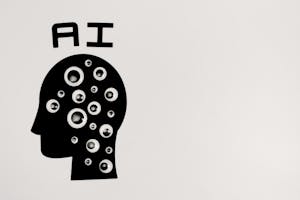INTRODUCTION
The complexity and expansion of data in the healthcare sector will lead to an increase in the application of artificial intelligence (AI). Various AI technologies presently used by payers, healthcare providers, and biosciences organisations. Suggestions regarding diagnosis and treatment, patient engagement and compliance, and administrative chores are among the key application areas. Implementation challenges will prevent the job of medical practitioners from ever becoming automated for a considerable length of time, despite the fact that there are many scenarios in which AI can do healthcare tasks equally as effectively or better than humans.
Artificial intelligence (AI) and related technologies are being employed in healthcare and are becoming increasingly widespread in business and society. Multiple studies have already demonstrated that AI is able to conduct critical tasks in healthcare, such as diagnosing illnesses, on par with or better than humans. Today, computers are already more accurate than radiologists in spotting malignant tumours and guiding scientists in the development of cohorts for pricey clinical trials. For several reasons, we believe it will be a while before AI entirely replaces humans in key sections of the medical process.
ARTIFICIAL INTELLIGENCE IN HEALTHCARE(1)
Artificial intelligence (AI) advancements in machine learning, deep learning, and similar emerging technologies were used in healthcare. The healthcare industry makes use of AI and data science to assess and manage patient data, insurance payments, and other medical data more efficiently. AI is improving medical outcomes, assisting challenging operations, and cutting expenses for pharmaceutical firms and healthcare providers. The following is a list of artificial intelligence applications in healthcare.
MACHINE LEARNING
A statistical technique called machine learning involves “teaching” models with data and “learning” by fitting models to that data. This general approach, which serves as the foundation for many AI approaches, comes in a variety of ways. The most common use of traditional machine learning in the healthcare sector is precision medicine, which chooses which therapeutic approaches are most likely to be successful for a patient based on a range of patient attributes and the context of the therapy. A training dataset with a known end variable, such as the onset of disease, is required for most of the machine learning and precision medicine applications.
Machine learning has evolved into artificial intelligence (AI). This technique, which has been utilised extensively in medical research for many years and has been around since the 1960s, is used for categorising jobs like determining whether a patient will get a particular disease. It tackles problems in terms of the “features” or weights of the variables that connect inputs and outputs. Although the parallel to how the brain functions is not particularly strong, it has been likened to how neurons process messages. One of the most challenging forms of machine learning is deep learning, which involves neural network models with multiple levels of features or variables that predict outcomes. These models could have thousands of hidden components that can be processed more quickly by modern graphics processors and cloud systems. To detect potentially cancerous tumours in radiological images, deep learning is commonly utilised in the healthcare sector.
NATURAL LANGUAGE PROCESSING
AI researchers have been attempting to comprehend how human language functions since the 1950s. Speech recognition, text analysis, translation, and other language-related applications are included in the field of NLP. Semantic NLP and statistical NLP are the two basic approaches. Recent advancements in recognition accuracy have been made possible by statistical NLP, which is based on machine learning and more especially deep learning neural networks. You need a substantial “corpus” or body of language to learn it. The main applications of NLP in the field of healthcare are the creation, understanding, and segmentation of patient records and published research. Conversational AI, creating reports (for instance, on radiological testing), analysing unorganized clinical notes on patients, and recording patient interactions are all capabilities of NLP systems.
PHYSICAL ROBOTS
At this time, physical robots are known. In environments such as factories and warehouses, they perform prescribed tasks such as lifting, moving, welding, or assembling goods, and transporting supplies in hospitals. Recently, robots have become more capable of cooperating with humans and can be more efficiently directed by having them perform desired activities. Additionally, a greater intelligence develops as additional his AI abilities are integrated into the “brain” (actually the operating system). It seems reasonable that physical robots would exhibit the same intelligent advances over time that have been seen in other areas of artificial intelligence.
However, critical decisions are made by human surgeons. Surgical robots, first approved in the United States in 2000, give surgeons “superpowers” such as improving vision, making precise, minimally invasive incisions, and suturing wounds. But important Decisions were still made by human surgeons. Common operations using robotic surgery include gynaecological surgery, prostate surgery, and head and neck surgery.
ROBOTIC PROCESS AUTOMATION
This technology executes organised digital administration tasks—those involving information systems—as if they were being conducted by a human user who was following a set of instructions or guidelines. They are less costly, simpler to programme, and more transparent than other types of AI. Robotic process automation (RPA) mostly uses server-based software rather than actual robots. To behave as a semi-intelligent user of the information systems, it depends on a mix of workflow, business rules, and ‘presentation layer’ integration. They are employed in the healthcare industry for routine duties including billing, prior authorization, and patient record updates. They may be used to extract data from, for instance, faxed images to feed it into transactional systems when paired with other technologies like image recognition.
Although we have only discussed these technologies individually, they are progressively being merged and integrated. For example, robots are acquiring AI-based “brains,” and RPA and image recognition are being coupled. These technologies will become so intertwined in the future that composite solutions will become more possible or practical.
RECENT TRENDS OF AI IN HEALTHCARE(2) IN DIAGNOSIS
Preliminary diagnosis: By analysing the data from prior diagnoses and learning to make diagnostic conclusions, AI-backed systems or solutions can assist in the diagnosis of a variety of ailments, from malignancies to eye disorders. And by quickly scanning through millions of photos, AI and ML-based technologies can identify difficult conditions like cancer and celiac disease. This can be completed more quickly than by humans, and it can be useful for disease detection in isolated or rural locations where there aren’t any physicians or specialists. By identifying anomalies in medical pictures, including CT, MRI, and radiography scans, automated image identification can assist in the detection of cancers, bone fractures, kidney and liver infections, and other disorders.
Connected medical devices: Connected medical equipment gives doctors real-time updates on a patient’s health and alerts them if something is wrong. Another example of an AI-based development in digital healthcare is linked medical devices, which range from basic glucose monitors to sophisticated insulin administration systems and wearables.
TELEMEDICINE
Telemedicine is the use of interactive digital communication to transmit medical information to conduct consultations, medical examinations and procedures, and medical professional collaborations remotely.
Example: Patient Monitoring – Telemedicine’s earliest and most popular use is for patient monitoring. This enables a quicker and more affordable method of conducting routine doctor-to-patient consultations to evaluate the patient’s present condition and clinical outcomes from a distance.
AUGMENTED REALITY AND MIXED REALITY
Mixed reality (MR), also referred to as “hybrid reality” and “extended reality,” has the potential to transform virtually every sector of the economy, including healthcare. MR is a new technology that combines Virtual Reality (VR), Augmented Reality (AR), and Artificial Intelligence (AI) to create experiences that combine parts of the actual world with digital ones. Incorporating mixed reality technology could enable enhanced surgery, instant diagnostics, and medical training.
Recent uses of mixed reality in healthcare include the Apollo ProHealthDeepX programme at Apollo Hospitals, which uses machine learning, digital signal processing, and mixed reality to assess a patient’s risk factors for heart disease and provide a visual insight into the internals of the heart using 3D images.
BIOPRINTING
The utilisation and effectiveness of scaffolds loaded with cells have been significantly improved using the quickly evolving area of 3D bio-printing. Skin, blood vessels, hearts, and other tissues and organs have all been generated in vast quantities using 3D bio-printing during the past few decades. They can be used as in vitro models for pharmacokinetics, drug screening, and other applications in addition to acting as the foundation for the ultimate objective of repair and regeneration.
• An innovative 3D printing plant made a debut in Bengaluru, India, in July 2022. To launch a line of desktop and industrial 3D printers in the India market in February 2022, Imaginarium teamed up with Ultimaker.
• The first producer of metal 3D printers in India, Intech Additive Solutions Pvt. Ltd. (Intech), announced the release of the iFusion LF series in 2021, a line of large format metal 3D printers with a high build rate for economical production. This signalled a growth in the company’s selection of metal 3D printers.
• The Andhra Pradesh MedTech Zone (AMTZ), India’s first medical device park, opened its 3D Bioprinting facility to advance diagnoses and treatment through the Bio Harmonized Aids for Rehabilitation and Treatment (BHARAT) initiative.
THE SCOPE OF AI IN FUTURE OF HEALTHCARE
In our opinion, AI will have a significant impact on future healthcare options. Precision medicine, which is widely regarded to be a much needed advance in healthcare, is mostly made possible by this ability. It takes the form of machine learning. Although early attempts at making suggestions for diagnosis and therapy have been difficult, we anticipate that AI will eventually become proficient in that field as well. Given the quick development of AI for image processing, it is possible that most radiology and pathology images will someday be examined by a computer. Speech and text recognition will be used increasingly often for tasks like patient communication and clinical note transcription. It will take far longer than it takes for technology to improve, but these issues will ultimately be handled.
Not determining whether the technologies will be capable enough to be beneficial, but rather guaranteeing their acceptance in routine clinical practise, is the biggest hurdle for AI in various healthcare sectors. In order for AI systems to be widely adopted, they need to be endorsed by regulatory bodies, integrated with EHR systems, sufficiently standardised so that similar products function, similarly, taught to clinicians, paid for by public or private payer organisations, and improved over time in the field. It will take far longer than it takes for technology to improve, but these issues will ultimately be handled. Therefore, we anticipate limited adoption of AI in clinical practise within 5 years and more widespread usage within 10 years’ time frame.
In addition, it is becoming more and more clear that AI systems won’t completely replace doctors in patient care, but rather work alongside them. Human physicians may eventually gravitate toward duties and work arrangements that make use of particularly human abilities like empathy, persuasion, and big-picture integration. Those healthcare professionals who refuse to collaborate with artificial intelligence may end up being the only ones to lose their professions in the future.
Bibliography
1. Davenport T, Kalakota R. The potential for artificial intelligence in healthcare. Future Healthc J. 2019 Jun;6(2):94–8.
2. Parry CM, Aneja U. Artificial Intelligence for Healthcare: Insights from India. [cited 2023 Jan 27]; Available from: https://www.chathamhouse.org/2020/07/artificial-intelligence-healthcare-insights-india-0/3-ai-healthcare-india-applications










